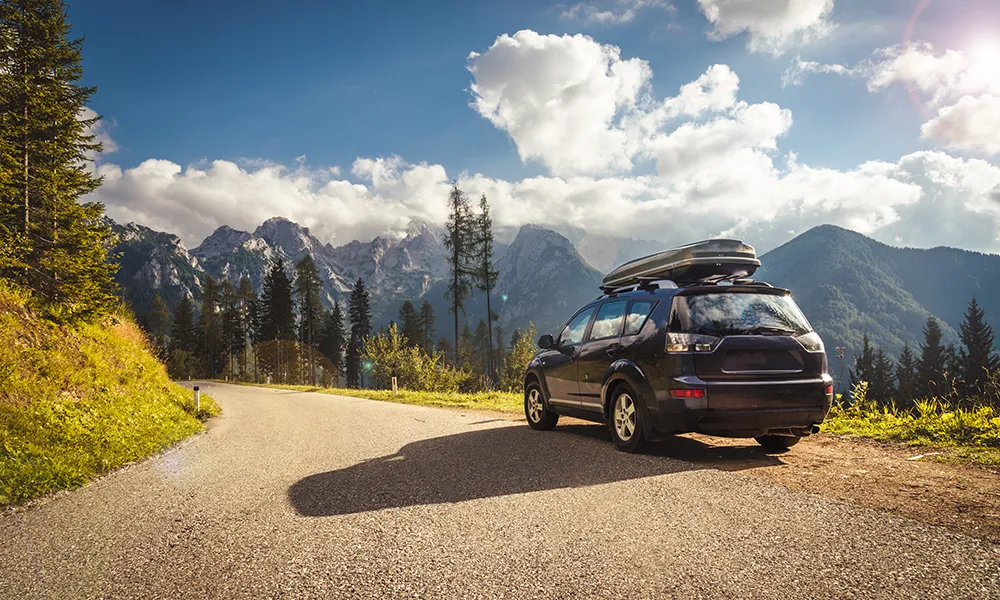10 Essential Things to Check Before You Set Off on a Road Trip
18 Feb 2025

Nothing beats the thrill of hitting the open road on a long-awaited road trip. But to keep that excitement going throughout your journey, you need to make sure your car is ready and raring to go before the adventure begins.
To help you have a stress-free trip, we’ve put together a list of 10 essential things to check before you set off.
1. Check your engine oil level
Checking your engine oil level regularly is essential for keeping your car running smoothly and preventing engine damage - which can be costly. Engine oil keeps your vehicle running, lubricating engine components, reducing friction and helping to keep the engine cool. When oil levels are too low, these benefits are reduced, which can lead to excessive wear and overheating, ultimately shortening the life of your engine.
Regular oil checks not only mean that the oil level is adequate but also give you a chance to assess the oil’s condition. During these checks, take a moment to assess the oil’s condition as well as its level. Conventional (mineral) oils tend to appear darker compared to synthetic oils due to their natural composition, so keep this in mind when visually inspecting. However, oil that appears excessively dark or dirty may indicate it’s time for a change, as old oil can lose its protective properties and may fail to properly lubricate the engine. By keeping an eye on these details, you can maintain engine performance, increase fuel efficiency, and reduce the risk of unexpected breakdowns.
If you’re uncertain about recognising signs that your oil needs changing, read our guide on engine oil warning signs to help you stay proactive.
2. Inspect your coolant level
Next, it’s time to turn your attention to coolant level. Keeping your engine cool on long drives is essential, particularly if you’re driving in warm weather. So, before you set off, you should check your coolant is filled to the proper level. Consider topping it up with antifreeze to prevent overheating and keep your engine in optimal condition. This is particularly important if you are travelling through regions with extreme temperatures.
3. Do a brake fluid check
Brakes are a vital safety component, especially on winding or steep roads. Check the brake fluid level and make sure it's at the recommended level. If it’s consistently low after topping it up, it might indicate wear on the brake pads or a leak in the brake system. In this case, it’s important to speak to a mechanic as soon as possible to fix the issue.
Take a look at our guide on how to check your brake fluid if you’re not sure how to do it.
4. Check tyre pressure and condition
Ample tyre pressure improves fuel efficiency and reduces safety risks. Before you hit the road, check your tyre pressure against your car manufacturer’s recommendation. You need to also assess if they’re in good condition and have sufficient tread depth. Don’t forget to check the spare tyre as well—it’s your backup plan for any tyre mishaps. Keep in mind that tyre pressure may need adjustment depending on altitude and temperature changes, which are common during long trips.
5. Top up your windscreen washer fluid
A clear windscreen is key for safety, especially when driving through different terrains and weather conditions.
Before your journey, check the windscreen washer fluid level and top it up with a suitable solution—preferably one that prevents freezing in cold temperatures and effectively removes dirt and grime.
Regularly maintaining the washer fluid allows you to quickly clear away dust, bugs, and debris that can obstruct your view. Additionally, inspect your wiper blades for wear or damage, replacing them if necessary to ensure they effectively clean the windscreen without streaks.
6. Inspect belts and hoses
Belts and hoses are critical for maintaining your car's health. Located under the hood, they connect different components of the engine and cooling systems. Inspect belts (such as the serpentine belt), drive accessories (like the alternator and power steering pump), and hoses that carry fluids like coolant. Inspecting them can be done safely, but it requires some basic knowledge:
Here’s what to look for:
- Any signs of wear, cracks, or fraying on belts.
- Any leaks, bulges or visible damage to the hoses.
Caution: If you’re not familiar with inspecting belts and hoses, it’s best to consult a professional. Opening the hood and assessing these components can be challenging, especially if they’re hard to access. Additionally, a snapped belt or ruptured hose can lead to serious issues if left unchecked, particularly in remote areas where roadside assistance may be limited.
7. Check the health of your car battery
Before you hit the road, it's important to make sure your car battery is in good shape - even if you're not a car expert.
Here's how you can do it:
Look out for warning signs: Pay attention to how your car behaves. Have you noticed it taking longer to start? Perhaps the headlights dim when you turn the key? These are signs that your battery might be weakening and could potentially fail soon.
Inspect for corrosion: Open your car's bonnet (hood) and locate the battery. Look at the terminals (the metal parts where the cables connect). If you see a white or greenish powdery substance, that's corrosion, which can negatively impact the battery's performance.
Make sure the battery is secure: Gently try to move the battery. It should be firmly held in place. A loose battery can cause electrical issues or even damage other parts of your car. To fix this, you can tighten the clamp or bracket that holds the battery in place using a wrench or socket. But, if you're not comfortable doing this yourself, it’s best to find a mechanic that can help you.
Consider professional testing: If you're unsure about the battery's condition, many auto shops offer free battery testing. They'll let you know if it needs replacing.
Caution: Always take care when handling the battery and inspecting under the hood. Avoid touching battery terminals directly, and wear gloves if possible to protect against potential acid exposure or shocks. If you’re unfamiliar with car batteries, consult a professional to ensure safe and effective handling.
Taking a few minutes to inspect your battery can save you from unexpected troubles on your trip.
8. Test all car lights
Working car lights are essential for safe driving and driving with faulty lights can result in fines or penalties. Addressing light issues before your trip can save you from being pulled over or experiencing visibility problems.
Here are the car lights you should check are working correctly when preparing for a long road trip:
[Note: You might need someone to assist you with this]
- Headlights (both low beams and high beams)
- Test your indicators
- Check your hazard lights
- Brake lights
- Check your tail lights
- Reverse lights
- Fog lights (if they’re required)
If you notice any burnt-out bulbs when you’re checking your lights, they will need to be replaced. Your car manual can tell you which bulbs you need. After replacing any bulbs, run through the checks once more to ensure everything is working.
As well as checking that the lights switch on, you should also assess the condition of the lights. Look for any cracks or condensation as damage to the light covers can reduce effectiveness. It’s also a good idea to clean the lenses and wipe off any dirt or grime that interferes with brightness.
Top Tip: It's a good idea to carry spare bulbs on long trips.
9. Check lubricants for moving parts
Your vehicle’s moving parts, like door hinges, the hood latch, and window mechanisms, should be properly lubricated to avoid any inconvenient squeaks or jams. Lubricants are ideal for ensuring all those moving parts function smoothly, adding to your comfort on the road, regardless of the climate or terrain.
10. Prepare an emergency kit
Unexpected situations happen, no matter how prepared you are. Be ready for unplanned issues with an emergency kit. This could include items such as:
- A first-aid kit
- Torch
- A jack
- Jump cables
- Extra water
- Non-perishable snacks
- Blankets
- Engine coolant & anti-freeze
It’s always better to be over-prepared when you’re far from home, especially if you're travelling in remote or unfamiliar areas where help may not be readily available.
With these 10 essential checks, you can confidently hit the road, knowing your vehicle is as ready as you are.
Wondering how to prevent wear and tear during your road tip? Take a look at the bad driving habits you should avoid if you want to keep your car in good shape.

